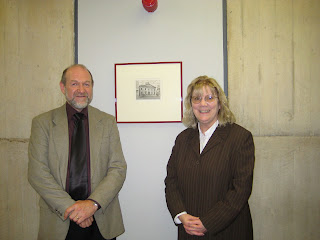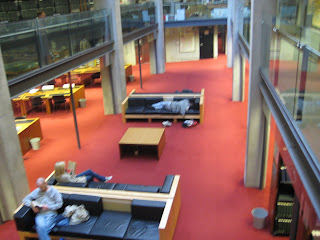(Web Site address: http://www.tcd.ie/Library/)
Despite a nightmare car ride and taxi ride (I promise never to attempt to drive in Dublin again), I somehow managed to arrive at Trinity College. A student from Clare helped find the library

Here I am photographed with Jessie Kurtz, the Deputy Librarian. The picture between us is of the common room where we took coffee. (I have to say it is better than the SWTAFE staff room, but don't think I don't appreciate our home grown facilities). The library buildings and collections were amazing. Kerry Vickers would love it -- note Kerry that the reader services librarian is called Keeper (Reader Services). Many thanks to Jessie, Trevor, Pat, Romona and Anne-Marie and Robin for their informative chats and tours.

Note student asleep on couch in Trinity reading room.
Trinity College Library is the largest library in Ireland. Its collections of manuscripts and printed books have been built up since the end of the sixteenth century. In addition to the purchases and donations of almost four centuries, since 1801 the Library has had the right to claim all British and Irish publications under the terms of successive Copyright Acts. The bookstock is now over four million volumes and there are extensive collections of manuscripts, maps and music. The Library has a triple rôle. As a university library it serves the needs of the College's undergraduate and postgraduate students and of the academic staff; it is also a research library of international repute, making available much rare material to scholars from all parts of the world. In addition, it provides an information service to government departments, to research organisations and to technical, industrial and commercial bodies within Ireland.
One interesting aspect is the mode of providing off-Campus access to electronic resources - On your home computer, you have to specify the Trinity proxy server in the options or preferences of your web browser. When this is done, and the browser is launched, the Trinity server will send a dialog box asking for a User Name and Password - this checks if the user is really a College member. The password that is required is known as your ‘local webaccess’ password (not the usual network login password!). If the User Name and Password is successful, the browser is launched and the machine will appear to the rest of the world as if it is on campus. (http://www.tcd.ie/Library/resources/offcampus.php)
The wireless network at Trinity (http://isservices.tcd.ie/network/genreq.php#wireless) can be accessed by students and staff with their own laptops. A wireless network card is required.
The library regulations are at http://www.tcd.ie/Library/libraries/regulate.php
All readers are required to observe the terms of the Library declaration
'I,...., do solemnly promise that, whenever I enter the Library, I will treat the books and other furniture of the Library in such fashion that they may last as long as possible. I further promise that neither will I myself take away any book nor designedly damage or write in or badly treat in any way whatever any book, nor so far as in me lies will I suffer such things to be done by others. All and each of which things and all the Statutes of the Library, in as far as they concern me, I promise and vow faithfully to observe.
The Book of Kells is by far the Library's most famous book and is located in the Old Library, along with the Book of Durrow, the Book of Howth and other ancient texts.
The Book of Kells is the centrepiece of an exhibition which attracts over 500,000 visitors to Trinity College Dublin each year. Written around the year 800 AD, the Book of Kells contains a richly decorated copy of the four gospels in a latin text based on the Vulgate edition (completed by St Jerome in 384 AD). The gospels are preceded by prefaces, summaries of the gospel narratives and concordances of gospel passages compiled in the fourth century by Eusebius of Caesarea. In all, there are 340 folios (680 pages). The script is embellished by the elaboration of key words and phrases and by an endlessly inventive range of decorated initials and interlinear drawings. The book contains complex scenes normally interpreted as the Arrest of Christ, His Temptation, and images of Christ, the Virgin and Child, St Matthew and St John. Originally a single volume, it was rebound in four volumes in 1953 for conservation reasons. Two volumes are normally on display, one opened at a major decorated page, the other at a text opening.
Also incorporating the Long Room, the Old Library is one of Ireland's biggest tourist attractions, and holds thousands of rare, and in many cases very early, volumes.
Though the Book of Kells has been exhibited in other locations, damage caused on a loan in 2000 to an Australian institution has led to a policy of never allowing the book to leave Trinity again.
Needless to say the visit was extremely interesting and provided me with many valuable ideas.
Great job Michael,Trinity College Library sounds terrific, a successful blend of old and new.
ReplyDeleteHi Michael
ReplyDeleteIt all sounds so facinating. Wondered what you envisaged when you had to shut your eyes and imagine a library in the future?
Well done!
Cheryl
Would sleeping on the couch constitute a misuse of library furniture?
ReplyDelete